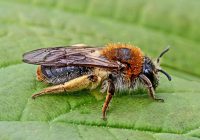Dr Phil Smith’s Wildlife Notes
April 2021
According to the Met. Office, April was: “An incredibly notable month in terms of statistics.” It provided the lowest average minimum mean temperatures for the country since 1922 and was one of the sunniest and driest Aprils on record. Here, not a drop of rain fell for 30 days between 28th March and 27th April. As reported last year, these spring droughts are known to be linked to climate change but the general public is not being told this.
As in April last year, the dry sunny weather was good for insects but not for wild plants. At the month’s end, the dunes looked parched, with little new growth. We were lucky that there were no major fires. The largest at Cabin Hill National Nature Reserve covered about 100 x 50 m, being constrained by sandy tracks and light winds.
I need to begin in late March with a rare visitor from the south, a Striped Hawkmoth that Richard Walker found in his moth-trap. There is only a handful of records for Sefton, most in the early/mid 20th century of this large moth, whose real home is around the Mediterranean. Trevor Davenport kindly sent me a photograph of this beautiful creature.
Turning to April, the ‘insect of the month’ for me was the tiny Spring Heath Robberfly. In Britain, it is restricted to southern heathlands and a few coastal dune systems. It was thought to be rare on the Sefton Coast until I found several last spring. Being wise to its likely presence, I kept an eye open and recorded the remarkable total of 29 during April, most being photographed. Several were eating prey in the form of small flies.
A singing Chiffchaff was a backdrop as I strolled down Formby’s Range Lane on 2nd. The first Black Poplar catkins were showing but about a week late. I was on my way to the Devil’s Hole blowout which was still deeply flooded, making it difficult to measure the height of the water-table. My notebook records that the site “looked like Blackpool beach” with 38 people present. The National Trust had erected a number of new signs requesting that, “To help protect rare Natterjack Toads” dogs should not be allowed in the water. Nevertheless, during the short time I was there, several dogs dived in. I also visited the nearby south-facing edge of Ravenmeols woods several times during the month, mainly for its hoverflies. These included one of Britain’s most spectacular insects, the Buff-tailed Bear Hoverfly. A mimic of the Common Carder Bee, this magnificent creature is uncommon in our area. Another impressive insect at Ravenmeols was the lovely Orange-tailed Mining Bee, one of dozens of species of bee that inhabit the dunes.
Falklands Way dunes and the adjacent Ainsdale Sandhills Local Nature Reserve were also productive. Highlights included several Spring Heath Robberflies on sandy paths, together with a large colony of Sweet Violet on the edge of woodland that was planted here in 1973. Several collapsed and rotting Silver Birches were a reminder of their short life-span and that tree-planting is not always a good way of storing carbon in the long term. I was able to confirm the identity of the Don’s Willow found in March, though the catkins showed it was a male, not a female as first thought. A Mediterranean Gull flew over, its distinctive calls being quite different from those of the Black-headed Gulls about to nest on Ainsdale National Nature Reserve. As I walked back, one of three Wheatears posed nicely on a bush.
On 23rd, Cabin Hill Wood had its usual display of hybrid Bluebells and Primroses, attracting a plenty of butterflies, including Orange Tips, Speckled Woods, Small Tortoiseshells, a Comma and Large, Small and Green-veined Whites. A Spring Heath Robberfly landed briefly on my camera bag. Nearby, a Mallard with eight ducklings was on the large flooded borrow-pit, a Little Grebe called from the reeds, while four Lapwings displayed noisily over the reserve. A common sound in my youth but now rare, it prompted a couple waking past to ask what type of bird was making that strange noise. A recently arrived Grasshopper Warbler reeled from a Yew bush on the open dunes, an Emperor Moth bombed past at high speed and a smart Coastal Silver Stiletto fly, with more Spring Heath Robberflies, basked on the warm sand around a Natterjack scrape.
Another regular trip during the month was along Wick’s Path to Wick’s Lake at Formby Point. Spring Heath Robberflies featured again, this time on a sunny, sheltered fence line. Also here was the bristly parasitic fly Tachina ursina, whose furry coat helps it to keep warm in early spring. One of several solitary beesI photographed was identified by Ben Hargreaves as the Grey-patched Mining Bee, a southern species for which there are very few Sefton records. These visits were invariably serenaded by Chiffchaffs, Willow Warblers and Blackcaps, while ten Siskins singing from poplars at Wick’s Lake on 27th were a surprise; no doubt May will provide many more.






